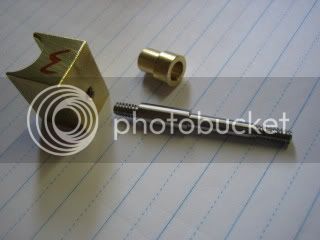Hi
I machined the cylinder to the required width of 1/2 inch.
The pivot will be made from 1/8 stainless steel. I need this to be a good fit in the 1/8 hole that will be drilled in the cylinder so I did a test drill on some scrap ally first. Drilled under size then finished with an 1/8 end mill.
Its a good fit.
Make the pivot.
Set the cylinder up in the mill and use an edge finder to get a datum. You can just see the laser red dot on the edge of the cylinder.
Centre drill.
Drill.
Finish with the end mill, 5/32 deep. Don't go right through into the cylinder.
Machine away the cylinder face.
The pivot pushed into the cylinder with flux and a small amount of silver solder wire.
In the brazing hearth.
Even though the pivot was a tight fit in the cylinder, after silver soldering I tried it in the frame only to find the two faces weren't parallel. I drilled a 1/8 hole through some scrap all and clamped it to the cylinder then re-heated to melt the silver solder and align the pivot.
I'm not completely happy with the outcome. The piston wouldn't fit in the cylinde so I had to ream it out again. The piston now fits but its not as good as it was in the first place. If I were to make the cylinder again using this method of construction I would make a jig to hold the pivot true while I silver soldered it in place. I think a better way would be to cut a couple of threads on the end of the pivot and tap the cylinder. Then assemble the cylinder/pivot/frame together with spot of loctite on the thread. This would ensure that the two faces meet accurately.
The original plans call for the crank pin to be 3/32. I don't have a 3/32 reamer so I upped the size to 1/8, a reamer size I do have. This means that the drill jig will have to be modified. To re-locate the hole I set the jig up loosely in the mill. With a centre in the quill bring it down till it enters the hole and centres it. Then tighten the hold down clamp. Drill and ream the jig 1/8.
Place the jig on the pivot and push a piece of 1/8 rod through the jig and the crank pin hole.
Set up in the mill. A short piece of copper tube with a nut and washer holds the jig still.
Drill the 1/16 hole.
A test fit in the frame. The holes line up perfectly.
Cheers
Rich


































































